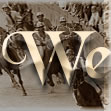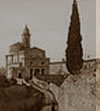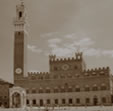Siena is one of the most artistically rich cities of Italy, with its important and well-known monuments, buildings and squares: Piazza del Campo is one of the most fascinating squares from medieval Italy.
Siena’s most antique art documents take it back to the beginning of the Republic in the XI century.
Nothing exceptionally interesting has remained from the Roman and Medieval periods. Siena’s Romanesque architecture is much less rich than that from Luca, Pisa or Florence. The most important work in Siena from that time period is the front body portion of the Duomo and the Ovile Fountain (1261).
Instead, Gothic style proved to be original and brilliant and flourished longer in Siena then in other Italian cities and shined and radiated into neighbouring territories. The San Galgano Church relic is a fine example of the ancient gothic art in Siena. The construction of the Duomo of Siena and its nave and double aisles, began in the XII century. It is entirely covered with marble and has a Romanic bell tower. The remarkable front facade was designed by Giovanni Pisano; it is one of his most important architectural masterpieces. One of the grandest buildings of Gothic Tuscany is the Palazzo Pubblico in Piazza del Campo (built between 1297 and 1342), with its Mangia Tower at 102 meters tall (1338-48 a.d.). The Tower is the work of Muccio and Franceso di Rinaldo, (students of Arnolfo di Cambio, the creator of the original project but who was not able to finish it due to a premature death). The upper tower is the work of Agostino di Giovanni. Piazza del Campo is the city’s main square, it is in the shape of a clam shell and it is where the biennial historic horse race takes place: The Palio. The monuments: Fonte Gaia by Jacopo della Quercia and the Cappella di Piazza constructed by Giovanni di Cecco (1352-1376) are located in the town square. The original Fonte Gaia sculptures are now protected in the Palazzo Pubblico and a copy is seen in Piazza del Campo. The Palazzi Tolomei are other examples from the Sienese Gothic period: Sansedoni, Saracini, Buonsignori, the Palazzo del Capitano di Giustizia (the Captain of Justice building), churches San Francesco, San Domenico, Santa Maria dei Servi (the Servants of Santa Maria) and il Battistero (Baptistery, the baptismal fountain was decorated with sculptures by Jacopo della Quercia, Dontello, Ghiberti, Giovanni di Turino, Truino di Sano and Goro di Neroccio).
There were many Gothic Sienese architects. Special recognition and merit for spreading this period’s art is given to architects Lorenzo Maitani, who oversaw the construction of the Duomo di Orvieto, Sozzo di Rustichino, who built the Duomo of Grosseto and Giovanni di Stefano, author of Fontebranda (Siena).
The Renaissance period asserted itself on Siena very slowly and even maintained Gothic characteristics. The graceful Loggia della Mercanzia by Sano di Matteo (1417-28) is characteristic of this transition period in Siena. Florentian artists Bernardo Rossellino and Giuliano da Maiano worked in Siena; the former constructed the Palazzo Piccolomini and the later the Palazzo Spannocchi. Even during the Renaissance period, Siena was the birthplace of many great architects who worked outside the city and contributed to the development of this new style: Francesco di Giorgio Matini, who was one of the most important architects of the time; Antonio Federighi, author of Loggie del Papa; Giacomo Cozzarelli di Bartolomeo di Marco; and special importance is given to Baldassarre Peruzzi, author of Palazzo Pollini (he worked for the most part in Rome).
The most remarkable architectural works of the 16th century are the San Martino Church (1537), works by Pelori, the Santa Maria di Provenzano Church and works by Domenicao Schifardini (1594).
Instead, from the Baroque period, we have Churches Saints Peter and Paul di Fiaminio del Turco, San Martino di G. Fontana and the Cappella Chigi in Duomo di B. Giovannelli. In the end of the 1700s we have the Church of San Giorgio by P. Cremoni.
Siena painting has its origins in the miniature art forms that appear in Benedictine Abbeys from the surrounding areas. Starting in the 13th century, Byzantine painting influences brought some original colour techniques. The first piece of work recognized as Sienese, dated 1215, is the Badia Berardenga frontal (today called the Pinacoteca). It’s ornament relief work demonstrates the figurative Sienese artform characteristics. Among other first works, Guido da Siena’s personality is remarkable in the great Madonna from 1221 (it can be found today in the Palazzo Pubblico). Guido’s influence was felt all throughout the 1200s up until the beginning of Duccio di Buoninsegna, who inaugurates the blossoming of this great Sienese period and is destined to compete with that from Florence. Duccio’s main work, La Maestà (1308-11), found in the Museum dell’Opera del Duomo, demonstrates the personal recreation of Byzantine and Gothic forms. All of his followers, and even later future Sienese painters, used this as a model of expression. Those disciples or imitators that had become well known were: Segna di Bonaventura, Ugolino di Nerio e Niccolò di Segna.
Duccio following acquires finesse and fresh colours through Simone Martini in his Maestà (1315) that is frescoed in the main hall of the Palazzo Pubblico together with the celebrated Guidoriccio da Fogliano (1328), it represents one of the highest moments of Italian Painting from that period. Simone Martini introduces the Sienese style to Naples and Avignone in Campania. He had many who imitated his style, such as Lippo Memmi, who collaborated with him in various works. With the works of Peter and Ambrogio Lorenzetti, Sienese painting acquires plasticity. This is particularly evident in the influence by Giotto and Florentian masters. The more refined and gentile temperament of Ambrogio (frescos Il Buongoverno-Good Government- and Il Malgoverno-Bad Government- (1338-40) in the Palazzo Pubblico) contrasts Pietro’s dramatic force (Crucification in the Pinacoteca, and Nativity in the Museum dell’Opera).
During the second half of the 14th century, Sienese painting had a large number of masters. They, however, didn’t know how to renew the styles of those masters who came before them: to name a few, Lippo Vanni (his works are in the Duomo, Seminary and Palazzo Pubblico), Niccolo’ di Ser Sozzo Tegliacci, Luca di Tomme’, Jacopo di Mino del Pellicciaio, Andrea di Bartolo, Paolo di Giovanni Fei. In the next century, the style and traditional forms were reaffirmed but with little variation in taste and technique, a slight decadence in Sienese pictorial art became evident. Florentine painting tends to absorb Sienese painting.
Florentine artists settle in Siena (Donatello, and later Piero and Antonio del Pollaiolo and Benedetto da Maiano). Instead, Sienese painters absorb other innovative styles by taking frequent travels to Florence. During this period the works of various artists stand out: Giovanni di Paolo (his works are in the Pinacoteca, at the Museum dell’Opera del Duomo, in Sant’Andrea, at Servi and in Santo Stefano); Stefano di Giovanni –known as the Sassetta- who was more lyrical and contemplative; in the works of Domenico di Bartolo, we can see the influences of Masaccio and Domenico Veneziano (the 1433 Madonna at the Pinacoteca, the Virgine at Refugio and the frescoes at the Pellegrinaio of the hospital of Santa Maria della Scala 1440-44); Sano di Pietro, Pietro di Giovanni and especially the painter and sculptor Lorenzo di Pietro, called the ‘Old Woman’ (frescoes in the Pellegrinaio 1441). The refined painter Matteo di Giovanni, with fine chromotism and light touches, was influenced by Piero della Francesca, (his abundant productions are found spread out at the Servi, in San’Andrea, San Domenico and at Madonna delle Nevi, and at Pinacoteca). Benvenuto di Giovanni del guasta and his son Gerolamo, Neroccio di Bartolomeo Landi (sculptor and painter), Franceso di Giorgio Martini are all active artists at the end of the century. By the beginning of the 15th century we have the Pinturicchio (autor of the Cappella Piccolomini in the Duomo), Giovanni Antonio Bazzi –known as the Sodoma-, Baldassarre Peruzzi, Girolamo del Pacchia, Beccafumi and Ventura Salimbeni. Rutilio Manetti (frescoes in San Bartolomeo) and Nasini are important artists to remember from the 16th and 17th centuries. And at the end of the 19th century we have Franchi, Aldi and Maccari.
The first representatives of Sienese sculpture date back to the 11th and 12th centuries. It seems that they formed a kind of corporation, regulated by particular statutes. Wood or Marble sculpture dating from that period of time can be found in the 1215 frontal that is at the Museum dell‘Opera del Duomo and in several Cathedral capitals. The first sign of importance is clear by recognizing it in the Pisan techniques and school. Nicola Pisano was called to Siena in 1255 to the Duomo pulpit. His son Giovanni stayed from 1284 to 1299 to complete the façade.
Several Sienese trained at the Pisan school: Ramo di Paganello, Tino di Camaino, Goro di Gregorio, Gano and Lorenzo Maitani, Agnolo di Ventura and Giovanni di Agostino (who was one of the great artists that contributed to the refacing of the Duomo). In the second half of the 14th century one can find works from Bartolomeo di Tomme’, Lando di Stefano, Matteo d’Ambrgio (authors of the pillar statures of the Cappella di Piazza di Campo) and at last Giovanni di Cecco (sculptures at the Museum dell’Opera del Duomo).
At the beginning of the 15th century, Sienese sculptors were Jacopo della Quercia (author of Fonte Gaia and the splendid decorations on the fountain of the baptistery of the Duomo), Domenico di Niccolo –known as de Cori’- (sculptor of San Pietro a Ovile and Stalli del Coro del Duomo, and now at the Palazzo Pubblico) and Francesco di Valdambrino (works in the Museum dell’Opera del Duomo).
The presence of Florentians Lorenzo Ghiberti, Donatello and Rossellino was crucial and they left many famous works in the city. Many imitated Donatello: Urbano and Bartolomeo da Cortona (see the altar of Madonna del Voto, 1451), Lorenzo di Pietro -called theVecchietta (Old Woman)- (whose statue of Santi Pietro and Paolo for the Loggia della Mercanzia), Neroccio di Bartolomeo, Francesco di Giorgio (bronze angels on the main altar in the Duomo, 1489), Antonio Federichi and Giaomo Cozzarelli. We must remember Domenico Beccafumi from the 1500s, he cast the bronze of the eight ash tray angels in the Duomo Presbytery.
Between the 17th and 18th centuries a family of sculptors from Cortona, the Mazzuoli family, left many works in Siena and in the 18th century works by Giovanni Dupre’ and Tito Sarocchi were prominent. We remember the latter’s great philological work on the reconstruction of the already deteriorating-in-time statue of Fonte Gaia (they can be seen by visiting the bottom floor of the Hospital of Santa Maria della Scala).







